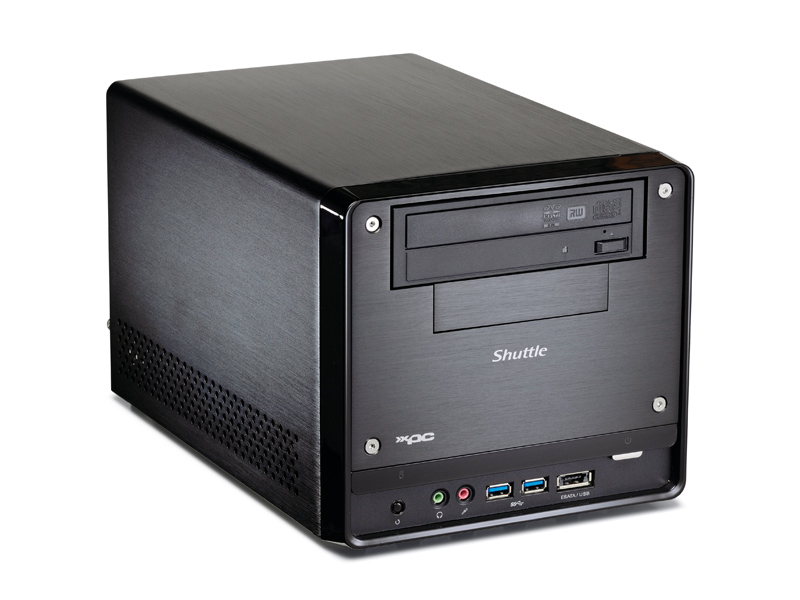TechRadar Verdict
Pros
- +
Size
- +
Specs
Cons
- -
Price
- -
Payoff
Why you can trust TechRadar
You know that moment where you're sitting at the tiny desk your landlord provided, enduring the sickly warm vibration of your PC pressing against your thigh, knees firmly clamped together, feet bound hopelessly in cables, thinking, 'I'm unhappy with this'?
Well, you could always go and get a bigger desk I suppose, but that's letting the space-hogging PC win. It'll never respect you after that moment. The other option is to buy a PC like this, the catchy SH67H3 from Shuttle.
The system we have here is built by Ambros, and though the component choices are entirely customisable online, this particular spec falls into the 'gaming PC' category.
Smaller form factors than the standard ATX carry a reputation for being inappropriate for serious gaming. Overheating and lack of room are common concerns and, while not entirely unfounded, they are a bit outdated in today's market.
We saw a Shuttle PC with an X58 motherboard capable of keeping the i7 990 EE chip at sensible temperatures only last issue, which should shush anyone hating on mini-ATX. Small things come in small packages, as the saying goes. Wait, what's the saying?
So here we have a DirectX 11 gaming PC with a Sandy Bridge processor that's roughly the size of a toaster. In the graphics card department, Ambros has appointed the GTX 460 head of operations. The advantages of this are twofold; it's a compact card compared to beefier Nvidia and all decent AMD GPUs, and offers great value in its Fermi architecture and clock speeds. It always did run a little hot, though.
Happily Shuttle is a bit clever at cooling solutions in tiny spaces, and we didn't see load temperatures exceed 60°C in either CPU or GPU readouts.
Sign up for breaking news, reviews, opinion, top tech deals, and more.
The GTX 480 has similar pros and cons, but to greater extremes – the GTX 460 is as good a card for this diminutive system as any, then. Don't even think about SLI arrays further down the line though; this isn't the system for multi-GPUs.
i5 with my little eye
The stock Core i5 2500K is no surprise either. The H67 chipset is on the one hand more appropriate for diddy systems as owners are unlikely to harbour overclocking ambitions and might well use the system for video editing, making use of the quick-sync hardware-accelerated video conversion.
To that end, however much ground the GTX 460 concedes to fresher cards in gaming, it's still super-powered for handling video and image manipulation tasks. For all its compactness though, the price is high, and value is low if you're looking at the SH67H3 as a gaming PC.
We have also reviewed the Chillblast Fusion Rocket, which sports an i5 2500K overclocked to 4.5 GHz and an AMD HD 6950. How this reviewer fawned over it. The price? £750. That's £115 cheaper than this mini PC, and the Chillblast pwns it in all performance categories.
Benchmarks
CPU performance
Cinebench R11.5 Points: Higher is better
Shuttle SH67H3 - 5.14
Fusion Rocket - 7.12
X264 v3.0 Frames per second: Higher is better
Shuttle SH67H3 - 27
Fusion Rocket - 36
DirectX 11 tessellation performance
Heaven 2.5 Frames per second: Higher is better
Shuttle SH67H3 - 18.21
Fusion Rocket - 21.7
DirectX 10 gaming performance
Just Cause 2 Frames per second: Higher is better
Shuttle SH67H3 - 26.45
Fusion Rocket - 39.69
This means the only ace this machine has up its sleeve is the size. If such a compact machine is an absolute must, consider it. Anyone with more space can look elsewhere.
Follow TechRadar Reviews on Twitter: http://twitter.com/techradarreview

Ad creative by day, wandering mystic of 90s gaming folklore by moonlight, freelance contributor Phil started writing about games during the late Byzantine Empire era. Since then he’s picked up bylines for The Guardian, Rolling Stone, IGN, USA Today, Eurogamer, PC Gamer, VG247, Edge, Gazetta Dello Sport, Computerbild, Rock Paper Shotgun, Official PlayStation Magazine, Official Xbox Magaine, CVG, Games Master, TrustedReviews, Green Man Gaming, and a few others but he doesn’t want to bore you with too many. Won a GMA once.
